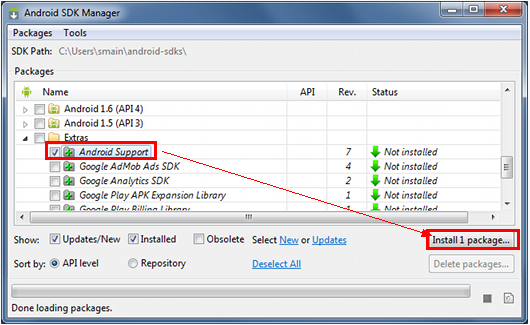編輯:關於Android編程
本文均屬自己閱讀源碼的點滴總結,轉賬請注明出處謝謝。
歡迎和大家交流。qq:1037701636 email:[email protected]
Android源碼版本Version:4.2.2; 硬件平台 全志A31
在介紹FrameWork是不得不提的是HAL(硬件抽象層)一般是用來和特點的硬件平台進行交互的,所以不同的android平台主要的區別也就是在這個部分,HAL的好處在於一個FrameWork可以調用不同的HAL,只需要相關的HAL滿足一定接口規范即可。另一方面HAL的好處是可以屏蔽相關對底層硬件操作的應用代碼。
網上對HAL的介紹內容已經很多,這裡就簡單和大家分享我所深入去了解的HAL層的相關規范。
核心的幾個API:hw_get_module(), hw_get_module_by_class(), load()就這麼簡單,核心在hw_get_module_by_class(),來看其實現的過程代碼:
int hw_get_module_by_class(const char *class_id, const char *inst,
const struct hw_module_t **module)
{
int status;
int i;
const struct hw_module_t *hmi = NULL;
char prop[PATH_MAX];
char path[PATH_MAX];
char name[PATH_MAX];
if (inst)
snprintf(name, PATH_MAX, "%s.%s", class_id, inst);
else
strlcpy(name, class_id, PATH_MAX);
/*
* Here we rely on the fact that calling dlopen multiple times on
* the same .so will simply increment a refcount (and not load
* a new copy of the library).
* We also assume that dlopen() is thread-safe.
*/
/* Loop through the configuration variants looking for a module */
for (i=0 ; i
step1:關注變量variant_keys, 通過系統屬性獲取函數property_get()來獲取下面4個屬性變量在內存的系統屬性中維護的數值(其中系統屬性的創建和維護主要由init進程來完成)
static const char *variant_keys[] = {
"ro.hardware", /* This goes first so that it can pick up a different
file on the emulator. */
"ro.product.board",
"ro.board.platform",
"ro.arch"
};
先來看ro.hardware,它一般是指定了系統板級的硬件如我這裡的sun6i, 那這個屬性變量在何處設置呢,首先出現的地方是在init進程裡面,依次調用如下:
1.get_hardware_name()——> fd = open("/proc/cpuinfo", O_RDONLY):搜索cpuinfo裡面的hardware字段,有的話就保存在hardware中
2.process_kernel_cmdline——>export_kernel_boot_props():這裡會對boot啟動時設置的屬性值查詢,對hardware有如下代碼:
/* if this was given on kernel command line, override what we read
* before (e.g. from /proc/cpuinfo), if anything */
pval = property_get("ro.boot.hardware");
if (pval)
strlcpy(hardware, pval, sizeof(hardware));
property_set("ro.hardware", hardware);
如果在boot時設置了ro.boot.hardware那麼hardware就重載從/proc/cpuinfo裡面讀取的數值,這樣整個ro.hardware的硬件系統屬性值就配置好了。
對於"ro.product.board"、 "ro.board.platform"、"ro.arch"這3個屬性變量,就要集中到android的屬性文件上來了,android系統集中的屬性文件有以下幾個:
android的基本屬性文件目錄:
#define PROP_PATH_RAMDISK_DEFAULT "/default.prop"
#define PROP_PATH_SYSTEM_BUILD "/system/build.prop"
#define PROP_PATH_SYSTEM_DEFAULT "/system/default.prop"
#define PROP_PATH_LOCAL_OVERRIDE "/data/local.prop"
以上文件將會在init進程裡面得到進一步的解析,關注到如下的代碼:
queue_builtin_action(property_service_init_action, "property_service_init");//屬性服務的初始化
屬性服務初始化action被加入到action隊列等待執行,執行函數execute_one_command,最終會回調上面注冊的action內的property_service_init_action,這裡就能看到屬性服務的從文件內部讀取維護到內存中:
void start_property_service(void)
{
int fd;
load_properties_from_file(PROP_PATH_SYSTEM_BUILD);
load_properties_from_file(PROP_PATH_SYSTEM_DEFAULT);可以看到會解析不同路徑下的prop屬性文件,包括下面要介紹的這個buil.prop
我們來看看/system/build.prop是由Android編譯時由編譯腳本build/core/Makefile和Shell腳本build/tools/buildinfo.sh來生成的,綜合了整個編譯配置環境下的平台相關變量,而這些變量往往在Android系統的關於設備信息中都能查看的到;
3 ro.build.id=JDQ39
4 ro.build.display.id=fiber_3g-eng 4.2.2 JDQ39 20140110 test-keys
5 ro.build.version.incremental=20140110
6 ro.build.version.sdk=17
7 ro.build.version.codename=REL
8 ro.build.version.release=4.2.2
9 ro.build.date=2014年 01月 10日 星期五 16:03:07 CST
10 ro.build.date.utc=1389340987
11 ro.build.type=eng
12 ro.build.user=root
13 ro.build.host=linux
14 ro.build.tags=test-keys
15 ro.product.model=Softwinner
16 ro.product.brand=Softwinner
17 ro.product.name=fiber_3g
18 ro.product.device=fiber-3g
19 ro.product.board=exdroid
20 ro.product.cpu.abi=armeabi-v7a
21 ro.product.cpu.abi2=armeabi
22 ro.product.manufacturer=unknown
23 ro.product.locale.language=en
24 ro.product.locale.region=US
25 ro.wifi.channels=
26 ro.board.platform=fiber
....
好了上面介紹了那麼多,其實已經涵蓋並跳躍了很多的內容,我們回歸到hw_get_module_by_class函數,下面就是確定在哪些目錄下進行優先的搜索,可以看到以下2個主要路徑:
/** Base path of the hal modules */
#define HAL_LIBRARY_PATH1 "/system/lib/hw"
#define HAL_LIBRARY_PATH2 "/vendor/lib/hw"
故而可知,當前的hal庫一般即只能放在這下面,否則找不到程序肯定不能正常運行,的確在編譯時我們不得不去手寫Android.mk裡面添加cp指令,完成當前庫的編譯並copy到上述2個目錄,一般與硬件平台更密切的庫放於/vendor/lib/hw,比如gralloc.sun6i.so hwcomposer.sun6i.so等就是這樣被找到的。
step2. 在完成搜索並定位到了對應庫的路徑之後,下面就是動態加載
load函數,主要將庫文件加載到,HMI所在的地址:
#define HAL_MODULE_INFO_SYM_AS_STR "HMI"
handle = dlopen(path, RTLD_NOW);
hmi = (struct hw_module_t *)dlsym(handle, sym);
這樣就獲取了當前庫文件的struct hal_module_info的信息即hw_m odule_t(內部有一個hw_module_methods_t* methods內部的open函數會向FW提供一個設備操作接口hw_devices_t),最終返回後就可以通過它操作相關的HAL中的封裝函數。
本文的重點是分析HAL的搜索以及定位HAL的過程,以便後續自己完成Android的定制。
handle = dlopen(path, RTLD_NOW);
 Android 進程間通信實現原理分析
Android 進程間通信實現原理分析
Android Service是分為兩種: 本地服務(Local Service): 同一個apk內被調用 遠程服務(Remote Service):被另一個apk調
 安卓實戰開發之SQLite從簡單使用crud
安卓實戰開發之SQLite從簡單使用crud
前言最近項目忙,然後呢很久沒有更新博客了,react-native也是沒有時間學習,然後項目裡面用到了數據持久化(數據存儲),Android系統中主要提供了三種數據持久化
 探究startActivityForResult在singleTop和singleTask啟動模式討論
探究startActivityForResult在singleTop和singleTask啟動模式討論
最近在研究AMS代碼遇到一個問題,在函數startActivityUncheckedLocked中 Slog.d("DDY", "!!
 Android 中 Fragment的使用大全
Android 中 Fragment的使用大全
Fragment必須總是被嵌入到一個Activity中,並且它的生命周期直接受宿主Activity生命周期的影響。本文內容可以分為下面的幾部分:使用支持庫創建